Fly Fishing for Schoolie Stripers
Get into saltwater fly-fishing with schoolie striped bass
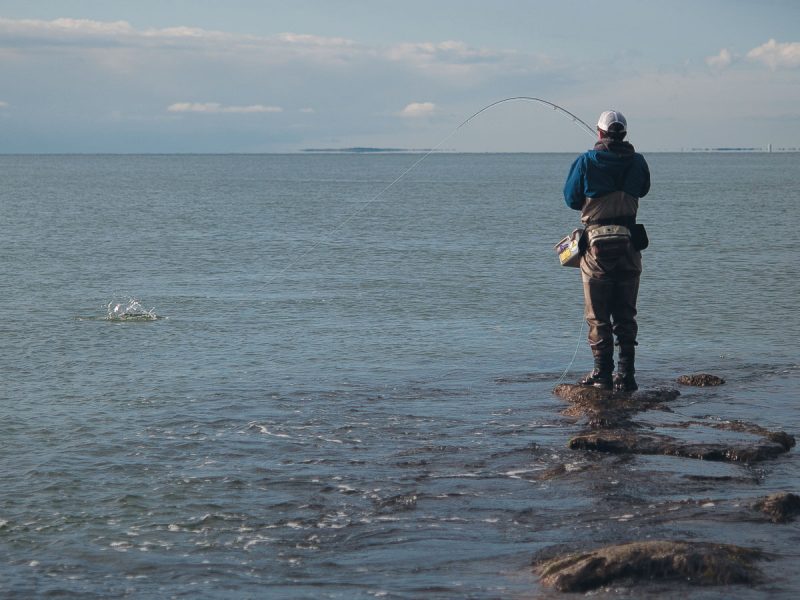
Striped bass are a great fly-rod fish. They are found everywhere: in the harbors of populated cities, the estuaries of small and large river systems, and across ocean beaches and islands from New Jersey to Maine. Schoolie bass can be caught on the fly for the better part of nine months in the Northeast, and their willingness to take a fly during the day or night presents endless opportunities. Schoolie stripers are the perfect gateway fish for anglers looking to learn how to fly-fish, and now is the perfect time to get into it.
Buying a saltwater fly-rod outfit is more affordable than ever. The fly-fishing industry has re-focused on the beginner who is getting into the sport by offering quality fly rods at half the price of what “entry-level” rods cost 10 years ago.
In the Northeast, a 9-foot, medium-fast action 9-weight rod is the most common choice and a great starting point for stripers. There are situations suitable for both heavier and lighter rods, but if you have to choose one, a 9-weight is the workhorse.
For reels, the ideal saltwater fly reel has a sealed drag system. There are many quality reels today in the $200 range that are lightweight, have sealed drags, and can hold plenty of backing.

I use intermediate cold-water fly lines for most of my striper fishing, and these are excellent all-purpose lines. Not only will they help load the rod when casting, they give you the ability to fish near the top, in the middle, and at the bottom of the water column, providing the most flexibility for an angler fishing from either the boat or shore.
I complete my system with a 9-foot fluorocarbon leader looped into the end of the fly line. I opt for simplicity, using a straight shot of 12- or 15-pound test for most locations.
The stripping basket, the bucket that I clip around my waist to hold the fly line, is essential equipment, and I won’t fish in saltwater without it. A stripping basket keeps the line from tangling in rocks and waves, leaving it clear for the next cast—or for when a big striper gets you on the reel. You can buy a stripping basket or make your own from a dishpan.
Choosing a Fly for Schoolie Stripers
Simple patterns work. The essential striper foods— sand eels, silversides, anchovies, juvenile menhaden and herring—are all ideal baits to be imitated with flies. Start by picking and using lightweight flies that you can cast well. Large, heavy patterns can make casting tough, even for experienced anglers.
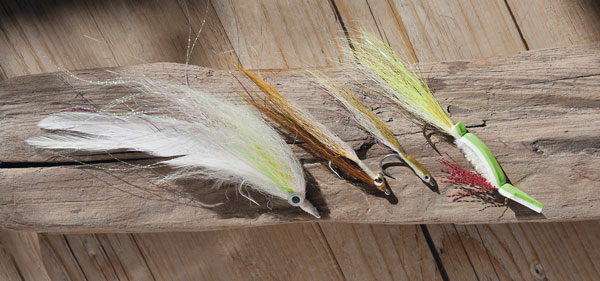
When filling out a fly box, stick with three or four lightweight patterns in varying sizes. Olive and white size 1/0 Clousers, size 2/0 yellow Deceivers, small Gurglers and epoxy sand eels like Popovic’s Surf Candy are my go-to patterns. For most of my beach and backwater fishing, I use any weighted fly that has white and chartreuse in it, while carrying slim 4- and 5-inch Deceivers, sparse gurglers for calm water, and small epoxy flies in pink or green to mimic sand eels. These give me the ability to target every part of the water column.
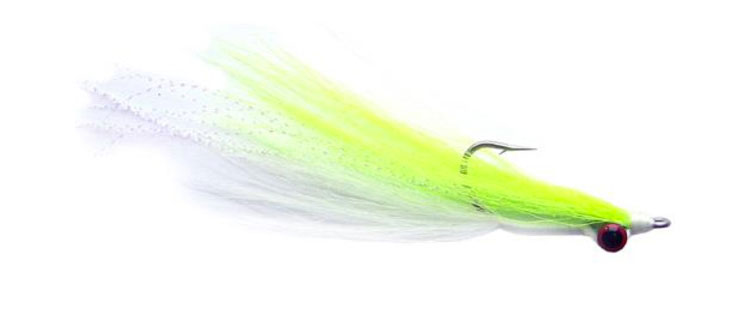
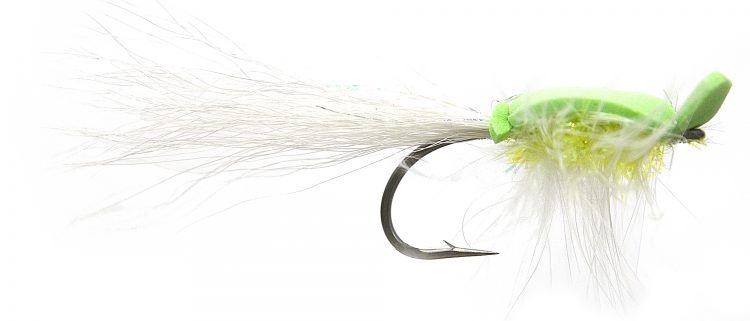
I generally start with a weighted fly and dart it along the bottom, then switch to a fly that suspends in the water or rides under the surface. I pay more attention to the length of the fly than I do the color. Once you find the fly that’s working, make note of the tide, time of day, and season, and you’ll be on your way to knowing what to tie on when.
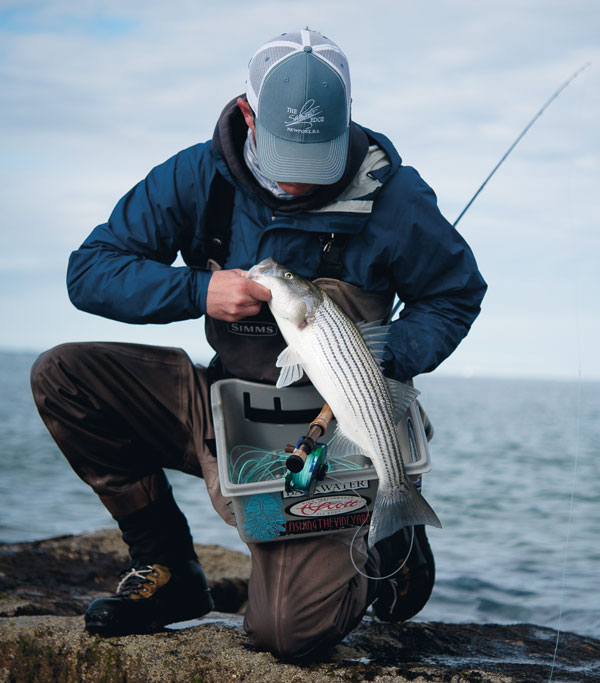
Fishing in Close
There is a common misconception that you must be able to cast a great distance to catch fish—for stripers, especially, this is not the case.
I can’t tell you how many stripers I’ve had swirl at or eat the fly 10 to 15 feet off the rod tip. Big fish, too. Shorter casts mean less line to worry about controlling, and easier and quicker line control when retrieving the fly. All it takes is one schoolie to eat the fly at your feet for you to realize that, often, you’re casting too far.
With short casts, keep moving and casting at different angles to the beach or structure. Fan-cast, covering water and depths as you move. When there’s no evidence of bait or fish, I’ll try covering as much water as possible. Instead of changing flies, I’ll spend more time switching up the retrieves.
Retrieve and Hookset
Develop a system of retrieves that will make the fly move in different waters. My go-to retrieve is a steady two-handed one with the rod tucked under my arm. The type of fly and how the water is moving will dictate the type and speed of the retrieve. “Low and slow” is a common saying for fishing deep with weighted flies. However, there are times when extreme variations in the retrieve will provoke a strike. I like aggressive retrieves in both moving water and flat-calm days. The pulsating, stop-start action can be killer. Keep trying until one works.
With a two-handed retrieve, you’ll often connect with more fish. Keeping the rod tip at or in the water will keep the fly in front of fish that swirl and miss. You won’t pull the fly completely out of the view of the fish, as often happens with a missed “trout set.”

Lou Tabory, the pioneer of fly-fishing for stripers in the Northeast, tells his students to use the rod to present the fly and fight the fish, but to use their hands to work the fly and hook the fish. The two-handed retrieve is a great method for hooking more fish.
Speaking of missed strikes, get in the habit of checking and regularly sharpening the hook of your fly. Rocks, shells, and sand will all take a toll on hook points.
The transition from feeling the line get tight on a fish to raising the rod to fight that fish is a time when things can go wrong. The biggest culprit of lost fish that I’ve seen with beginners is when the fish is big enough to clear some stripped line but not big enough to be fought on the reel. Don’t get into the habit of reeling in line with one hand while simultaneously trying to keep pressure on the fish with the other. Most schoolie stripers caught on the fly can be fought by hand. When you do cross paths with a fish that clears all the line for you, trust your drag and don’t fiddle with it. Keep side pressure on the fish and don’t get too aggressive with your movements–when a fish takes you into the backing, you don’t want to slip on a rock.
Fish the Fishy Water
For novice fly-fishermen, fly-fishing for stripers seems daunting because of how vast a bay or stretch of beach can seem. Fortunately, you can quickly eliminate large chunks of unproductive water to help find the areas where schoolies hold.
Some of the best areas to fly-fish are jetties. They have resident populations of baitfish and crabs, and because many jetties guard the mouths of estuaries or harbors, there is good moving water around them.
Plus, jetties offer the fly-fisherman access to deeper water that’s otherwise hard to reach from the beach. Often, the area where the beach meets the jetty can be a hotspot. I’ll generally fish from the beach on the lower tides and wade out along the jetty. Typically, you’ll know quickly if the bass are there. I like windy conditions when fishing a jetty, and the lee side is a great place to hide from the wind.
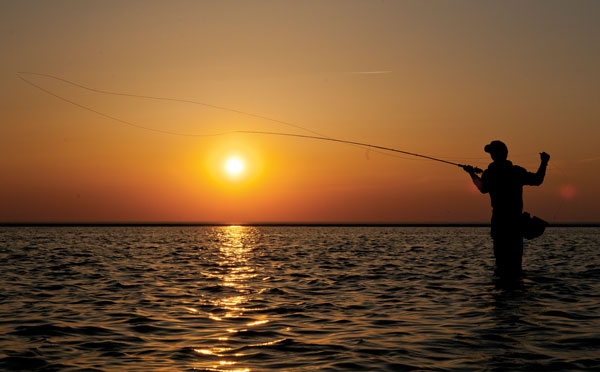
Dealing with Wind
Rocky points, jetties, and exposed beaches are all good places to target stripers, but they are regularly subject to strong winds. Aside from the impact it has on fly-casting, that wind will have an effect on the bait too. Wind blowing along a shoreline pushes bait into coves, alongside jetties, and into pockets. Wind blowing directly onshore pushes bait into the shoreline. Recognize what the wind is doing and look for the bait.
Part of my strategy for fishing with wind in my face is overloading the rod by using a 10-weight line on a 9-weight, fast-action rod so that I can feel the rod load quicker at shorter distances with less line outside of the tip. With a sidearm, low-angle backcast that keeps the fly away from me and a more deliberate, sidearm punch of a forward cast, the rod loads quickly and the wind can’t eat up the line. As you get more comfortable casting, double hauls will help turn over the fly and create better line speed.
Related Content
10 on “Fly Fishing for Schoolie Stripers”
-
LOU STILL WAITING FOR THAT NORWICH CONN. VIDEO OF CATCHING WINTER STRIPERS IN THE THAMES RIVER . IS IT COMING SOON ?
-
Gennady Dorowski THE BEST WINTER FLY
IS IN A TEAL EEL PATTERN.
ITS NOT LIKE WE’RE OUT THERE FISHING FOR SPERM WHALE OR ANYTHING.
THESE FISH ARE SMALL.
BETTER TO STAY INSIDE AND FIDDLE WITH THE OL’ NOODLE AND TIE SOME NEW FLIES TO GET READY FOR THE SPRING.
MAYBE GO CLAMMING ON A CLEAR DAY IF YOU MISS THE SEA. -
Fran Trump The orange streamer
A
Combover of waves
Let’s make angling great again
And hunt the predators not the prey -
Chris Thompson Patrick, I really enjoyed your article. Can’t wait to get back up to MV. Hoping you can give me some pointers this summer.
-
Patrick Thanks Chris. I can’t wait for Vineyard and spring as well. Let’s get out together this season with the long rods – Happy new year and hope all is well!
-
-
Uncloudy Day My favorite part is that even though the fly guys release these rats, most of them still die…”I got about 40 schoolies this morning but we gotta stop the commercial season” DUUHHHH
-
BnB “Most of them die…” Really? Why would anyone believe that? Because YOU say so? Show me ANY data that supports your claim that mortality is larger on school fish than on larger fish. I’ll wait.
…and spare me the “long fight” nonsense. Schoolies on an 8 or 9 weight are landed in seconds.
-
fishingmordor It’s the long fight.
-
-
Peter Crush your barbs
-
-
Steven martin What about sf Bay Area
Leave a Reply